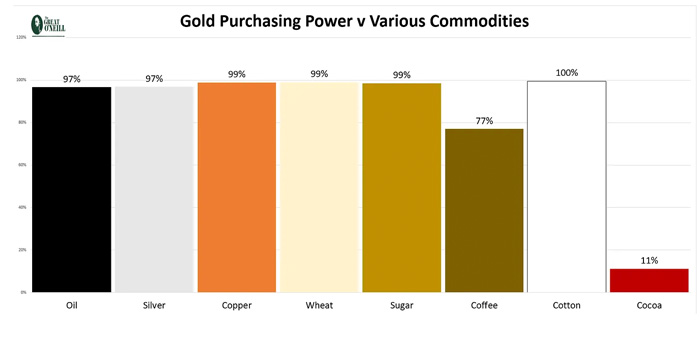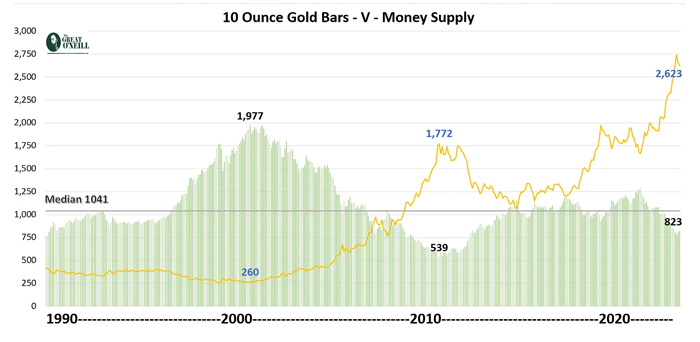Send this article to a friend:
January
08
2024
Send this article to a friend: January |
What Is Gold Whispering?
This commentary is an update and review of a commentary that we published in December 2023. The updated charts are once again very useful. Gold bugs such as myself consider Gold to be money. And yet the primary way in which we measure its worth is in fiat currency – mainly Dollars. However, its purchasing power can be measured in other ways. Measuring Gold against other commodities can be a useful exercise. In the first half of this commentary, I will make a case that Gold is actually quite expensive when measured against oil and a number of other commodities. This is interesting in its own right. In the second half of this commentary, I will measure Gold against the money supply. This is a little more complex. Gold Prices – V – Other Commodity Prices. Calculating the purchasing power of gold in other commodities is a simple exercise. If Gold is trading at $2,000 an ounce and Oil is trading at $100 a barrel, we can say that an ounce of Gold is worth 20 barrels of Oil. This ratio or purchasing power will vary over time. We will see in a moment that since 1990 an ounce of Gold was worth as few as 7 barrels of oil and as many as 92 barrels. We cannot know what the fair or correct exchange rate between gold and oil should be. But we can figure out the median or middle level. In this case, between January 1990 and December 2024, 17 barrels represents the median. In other words, half of the time the gold/oil exchange rate traded above 17 and half of the time below 17. Take a look at the chart below. Each green bar below represents the number of barrels of Oil an ounce of Gold can buy. These ratios are based on monthly average prices for both Gold and Oil (Brent Oil).
We can see from the black line on the chart that in 2008 when the Oil rallied sharply to over $130 per barrel, an ounce of Gold could only buy 7 barrels of oil (green bars). The collapse of oil prices in 2020 increased Gold’s purchasing power to 92 barrels. We can describe these Gold / Oil exchange rates using percentiles as follows: Lowest Exchange Rate – 7 Barrels – 0% Percentile Median Exchange Rate – 17 Barrels – 50th percentile. (50%) Highest Exchange Rate – 92 Barrels – 100th percentile. (100%) The last price on the chart is the exchange rate on Jan 1 2025 – 36 Barrels. This rate is the 97thpercentile. In other words, the Gold/Oil exchange rate has been lower than 36 barrels 97% of the time since 1990. A year ago an ounce of Gold bought 25 barrels (89th percentile). It is pretty plain to see that Gold is trading strongly against oil today. This percentile number is really the key data point. It tells us how cheap or expensive Gold versus Oil is. Now that we have established that Gold is trading at the 97th percentile versus Oil we can repeat the exercise for other commodities. Using the same parameters as in the oil chart above, the chart below cuts to the chase. Each bar below represents the percentile for Gold against various commodities including Oil on January 1 2025. 
Clearly, with the exception of Cocoa, Gold looks rich against this selection of commodities. Furthermore, in terms of the US Dollar, it is within touching distance of its recent lifetime highs ($2790). It ended 2024 at $2623. But this is not the whole story. We can learn a lot more by comparing Gold to the money (Dollar) supply. How many Dollars are out there? Measuring the purchasing power of gold versus the supply of money is a trickier prospect. The supply of money does not have a price. It is a quantity. In theory at least, as the quantity of money in circulation grows the price of Gold should adjust higher. The St.Louis Federal reserve bank gives us a measure of money supply called M2 for the United States. This is a measure of the total amount of cash, current and deposit accounts and some money market instruments in existence. We can use this number as a proxy for the growth in the total amount of dollars in existence over the years. The next chart is a ratio or exchange rate. It shows us how many 10-ounce gold bars it would take to match money (Dollar) supply in the United States. I have used the higher metric (10 ounces) for Gold in this analysis. It makes the charting a little easier on the eye. The data is monthly averages. Each green column represents the number (in millions) of 10-ounce bars that it takes to match the money supply. 
For clarity, let us take a look at some percentiles. I am describing these percentiles in terms of Gold’s strength or weakness. For example, when Gold was trading at $260 (yellow line) in 2001 it was at its weakest ‘exchange rate’ to money supply – 1,977m 10 ounce bars. Lowest (weakest) Gold Exchange Rate – 1,977m – 0% Percentile Median Gold Exchange Rate – 1040m – 50th percentile. (50%) Highest (strongest) Gold Exchange Rate – 539m – 100th percentile. (100%) Today (Jan1 ’25) it takes 823m bars to match Dollar supply (M2). 823m bars is the 87th percentile. This 87th percentile result casts Gold’s present high price ($2,623) in a similar light to the commodity analysis above. It looks a little rich, but not as rich as you may think. To reach its 2011 Dollar Supply ratio of 539 it would need to be exchanging hands at $4,000 per ounce! Finally. What is Gold Whispering In general Gold is trading firmly versus other commodities. Furthermore, using round numbers, Gold is up about 50% from its 2011 highs, but the Gold Miners Index (GDX) is down about 50% from its 2011 highs. This is an extraordinary rally in Gold relative to other commodities and Gold Mining Companies. It is very hard to plausibly reconcile this move. Another thing that makes this rally so unusual is how quiet it has been. No fan fair, no fuss and no screaming headlines. Private investors and financial news media appear to have barely noticed this rally much less participated it. This leads me to think that this rally is far from over. In December 2023 with Gold at $2073 I wrote: “Gold looks like it wants to go higher. ……………... However, this analysis has made me cautious. Gold is not cheap right now. Nevertheless, Gold is whispering – nation states are buying gold not because they want to, but because they need too. “ Gold is not just another commodity. It is a bedrock financial asset used by governments all over the world as a reserve asset. Major nations do not trade or accumulate any other commodity for their Foreign exchange reserves. It is an important bell weather financial asset. As a self-confessed Gold Bug I struggle to be neutral when assessing Golds prospects. I am inclined to focus on the Gold V Money Supply analysis (87% percentile). This allows me to think that there is nothing special about gold trading at $2623. There is plenty of room left for upside, ($4,000), and this excludes the inevitable future increases in Money Supply (M2). Following this line of thought, Oil, Silver, Copper and a host of other commodities will need to play catch up with Gold. Today, Gold is whispering that inflation is on its way. Thanks for reading The Great O'Neill! This post is public so feel free to share it. Subscribe to The Great O'NeillLaunched 3 years ago The Great O'Neill is a Commodity Trading Advisor (Hedge Fund). Our articles help the reader to learn something useful quickly. We cover markets and related affairs without the jargon or 'corporate speak'.
|
Send this article to a friend:
 |
 |
 |